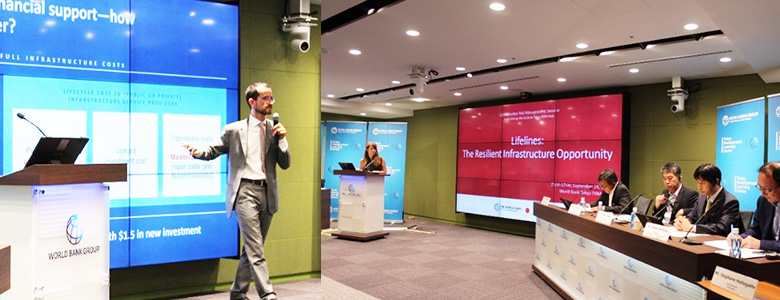September 24, 2019
Tokyo, Japan
Lifelines infrastructure - water & sanitation, energy, transport and telecommunication - is universally considered to be essential for raising and maintaining people’s quality of life. Yet millions of people, especially in low- and middle-income countries, are facing the consequences of unreliable infrastructure services and natural hazards magnify the challenges faced by these fragile systems. The World Bank addresses this development challenge in the recently published report “Lifelines: The Resilient Infrastructure Opportunity - Report presentation.”
Commemorating the publication of the Lifelines report, the World Bank’s Tokyo DRM Hub organized its 22nd public seminar on September 24, 2019, having Mr. Yasuaki Yoneyama, Director, Multilateral Development Banks Division, International Bureau, Ministry of Finance, for the opening remarks. He emphasized the importance of building resilience against natural disasters. The seminar stressed the importance of the partnership between Japan and the World Bank in mainstreaming DRM into policy and design of infrastructure projects, highlighting the report’s key findings and recommendations, and facilitating the panel discussion on good practices and lessons on resilient infrastructure.
Keynote speeches provided by Stephane Hallegatte, Lead Economist and lead author of the Lifelines Report and Mr. Kawamura, Counsellor, National Resilience Promotion Office, Cabinet Secretariat, explained the global challenges and opportunities for enhancing resilient infrastructure and highlighted how Japan is proactively building resilience through its “National Resilience Program”.
Main findings from the Lifelines Report Hallegatte introduced the finding of the Lifelines Report and the scale of the direct and indirect impacts on infrastructure from natural hazards, with US$ 18 billion annual damages/repair costs in developing countries and an additional US$ 391-647 billion in losses to households and firms due to infrastructure disruptions. Lifelines showed that investing in more resilient infrastructure has an economic net benefit of US$ 4.2 trillion over the lifetime of new assets. Hallegatte also explained that Lifelines developed an analytical tool to estimate the costs of infrastructure disruptions and determine the criticality of network investments, which is being operationalized across World Bank investment projects with support from the Japan Program. |
The World Bank Tokyo DRM Hub and GFDRR will continue to connect Japanese knowledge and expertise with developing countries through the Japan-World Bank Program to contribute to enhancing resilient infrastructure.At the Wrap-up session, as the moderator of the panel discussion, Julie Dana (GFDRR) expressed appreciation for Japan’s strong leadership on the DRM topic as well as the participation of the public seminar. She emphasized that Japan’s support is critical in the development of the Lifelines Report through technical inputs from academia and experts, peer-reviews, and a variety of case studies referred in the Report.
Mr. Masashi Saito (Hamamatsu City) highlighted the opportunities for increasing resilience under a PPP structure and enhancing risk management through disaster risk allocation among stakeholders. Mr. Hiroshi Sakuma (NEXCO East) shared its activities such as development of the Business Continuity Plan and a new initiative on ICT based asset management for highway. Mr. Daisuke Takeda (Toshiba Energy Systems & Solutions Corporation) presented technological solutions used in energy projects, focusing on power-supply stabilization technologies contributing to enhancing disaster response. Mr. Shinya Kitamura (Teikoku Databank) highlighted how big data can help visualize networks of economic activity and introduced the examples of post-disaster business transactions on the affected areas from flood and earthquake.The seminar hosted a panel discussion, inviting the Japanese experts from public and private sector. The session explored opportunities and challenges related to public-private engagements in enhancing disaster preparedness and infrastructure assets resiliency, and maintaining critical supply chains through infrastructure redundancy, continuity planning and big-data analytics.

(Right) Ms. Julie Dana facilitates the panel discussion with Japanese experts (Source: World Bank)
